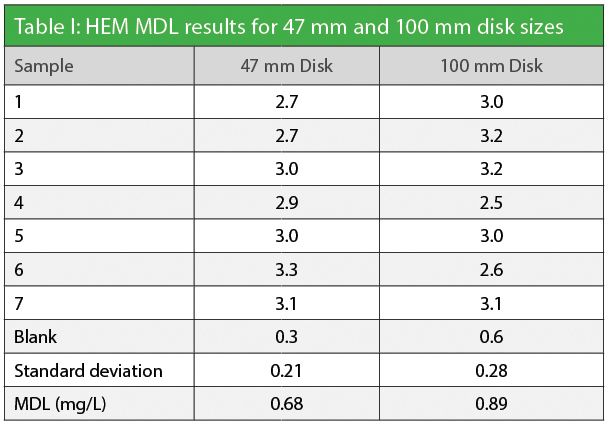Modern Hexane-Extractable Material (Oil and Grease) Analysis in Wastewater Samples
The Application Notebook
Initial precision was demonstrated by spiking four 1-L volumes with one Snip and Pour pre-measured standard, each (40 mg). The data for four replicates was collected for 47 mm Disks and 100 mm Disks. The average percent recovery is excellent and meets the criterion specified of 83–101% HEM recovery for both size disks. The standard deviation is better than the criterion specified of 11% for HEM.
n-Hexane-extractable material (HEM), often termed oil and grease, is an operationally-defined general measurement used around the world to help assess water pollution due to a variety of hydrocarbons, including dissolved aromatics, benzene, toluene, xylene, and dispersed polynuclear aromatic hydrocarbons (PAHs), aliphatics, naphthenic, and fatty acids. It is also used to determine the input into water treatment plants to ensure their continued good operation and to help keep sewer systems from becoming clogged with fats, oil, and greases. The measurement of the extracted material is done using a balance in regulatory methods US EPA 1664, ISO 11349, and Standard Methods 5520G, providing a simple and inexpensive detection step (1). A further silica-gel treatment can be used to isolate the nonpolar material in the n-hexane extract.
Hexane extractables can also be used as a metric to regulate allowable pollution. In the US this is done through a system known as the National Pollutant Discharge Elimination System (NPDES) where allowable pollution is listed by industrial category for regulation. Similar regulations are seen in Brazil, Malaysia, the Philippines, and other countries.
US EPA Method 1664 has allowed use of solid phase extraction (SPE) instead of liquid-liquid extraction with hexane since 2007 and this has been widely adopted in the US. On January 16, 2009, the US EPA released information regarding a modification to EPA Method 1664A. One of the modifications made was to disallow the collection of co-solvents like methanol. It is acceptable to rinse with methanol provided that it is discarded and not eluted into the final eluent. This change was later promulgated into 1664 Revision B. The SPE-DEX® 3100 is fully compliant and allows for the methanol to be discarded at the completion of the rinse process. This note will demonstrate the performance of the SPE-DEX 3100 for US EPA Method 1664B (2).

Table I: HEM MDL results for 47 mm and 100 mm disk sizes
The method detection limit (MDL) is determined from seven replicates of 1 L of reagent water, each spiked with 4 mg/L of standard. The MDL is better than the requirement stated in the method (1.4 mg/L), ensuring that low concentrations of HEM can be measured with the precision necessary.
Initial precision was demonstrated by spiking four 1-L volumes with one Snip and Pour pre-measured standard, each (40 mg). The data for four replicates was collected for 47 mm Disks and 100 mm Disks. The average percent recovery is excellent and meets the criterion specified of 83–101% HEM recovery for both size disks. The standard deviation is better than the criterion specified of 11% for HEM.
The automation of HEM (oil and grease) analysis using SPE for extraction meets the challenging and specific criteria set forth in US EPA Method 1664B. The SPE-DEX 3100 automated extraction system provides reproducibility and reduces operator exposure to solvent. Less solvent is used and the formation of emulsions is virtually eliminated. Additional features of the system provide the ability to handle heavily particulated samples reliably. Overall, automated SPE provides advantages even for smaller laboratories with fewer samples and increases productivity for larger laboratories with many samples to run.
References
(1) Method 1664, Revision B: n-Hexane Extractable Material (HEM; Oil and Grease) and Silica Gel Treated n-Hexane Extractable Material (SGT-HEM; Non-polar Material) by Extraction and Gravimetry, available at www.epa.gov, (2010).
(2) Modern Hexane-Extractable Material (Oil & Grease) Analysis in Wastewater Samples, AN1021601_01, available from www.horizontechinc.com.

Horizon Technology, Inc.
16 Northwestern Drive, Salem, NH 03079
tel. (603) 893-3663
Website: www.horizontechinc.com

Separation of Ultra-Short and Long Chain PFAS Compounds Using a Positive Charge Surface Column
December 11th 2024A separation of ultra-short and long chain PFAS (C1-C18) is performed on a HALO®PCS Phenyl-Hexyl column along with a HALO®PFAS Delay column which demonstrates excellent retention for both hydrophilic and hydrophobic analytes.

.png&w=3840&q=75)

.png&w=3840&q=75)



.png&w=3840&q=75)



.png&w=3840&q=75)













